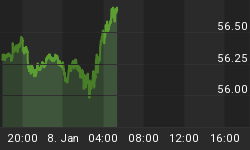Last week we attempted to explain how the "insiders" in a sense "control" the flow in valuable information given out to the public. So you may have heard it here first when we said that the Fed planned to discontinue the release of money supply figures, commonly referred to as M1, M2 and M3. Money simply serves as a standard of value for measuring the relative worth of different goods and services. Given that there is persistent government induced inflation, trading currencies necessitates understanding how much credit inflation is being generated throughout the system. Therefore, we will be charting M3 growth for you and reporting on it from time to time.
In the chart below we show M3 y/y growth (black) and CPI y/y growth (orange). The term money supply, in its most narrow definition, denotes currency in circulation plus bank and other deposits. As you can see, the Fed effectively squeezed out liquidity between 1976 and 1987, which resulted in a sharp decline in CPI.
Because of a more globalized economy, if we add all foreign-exchange reserves with the US monetary supply (M3) we estimate an additional 5% added to the average of 10% over the last 5 years which means we remain in an inflationary environment.

Note that the Fed does not directly increase the money supply, but it does influence credit inflation or deflation through its discount rate that it sets with banks. As you can see, the normal correlation between an increase in the supply of money and credit (beyond the productive capacity of the economy) creates inflation, as measured by the CPI (orange).

However, because of "substitutions" and "hedonics," the CPI no longer measures "inflation," but instead a perverted sense of the term. For instance, when something you buy goes up in price, the BLS finds a suitable "substitute" which it then places in the CPI basket, thereby proving that the very evidence of price inflation creates a similar and equal decrease in inflation. Hedonics measures quality improvements even though productivity improvements a priori translate into lower costs, meaning its effect is double counted.
Therefore, do you think that M3 growth back at 11% is evidence that the Fed has reined in inflation? The point is that while the lending rate has been normalized over the last two years with 17 rate hikes, the availability of money is more than ample. Yet, once again, the conventional wisdom is that rising Fed funds rates have led to the CPI's (orange) recent drop. Interestingly, our quick study here simply shows that GDP growth is slower than actually reported which means the Fed will continue make money readily available.
Stock Focus: Our discussion of money supply is important because we must never forget that in a highly evolved credit based economy, the strong rise in money supply has helped fuel the rise in stock prices.
However, as we have pointed out over the last 12 months, there has been an eye-catching increase in commercial net short positioning in the Dow. We have been hitting new record net shorts recently. To better understand the dichotomy, note that the strong increase in global liquidity has not attracted the "smart money" to stocks, but instead seen a coincident rapid retreat from them.

This is why we have said the key ingredient for the stocks is to see how the bond market reacts. If our estimate that bonds will hit key resistance and then decline, triggering another rise in rates, then stocks may be in for a rough ride, as predicted by the bearish stance from the "smart money."

Bond Focus: One reason our bond forecast has played out so well is that we have honed in on one concept - that rates are too low - and simply called out the inflection points in the market where we expect bonds to fall to, then base and get a countertrend bounce before falling again.
If we paid attention to the he said/she said, we'd say that Q4 GDP will get revised downwards and that the decline in stocks that we anticipate will ignite a rally in the long end of bonds. However, when we look at the global liquidity created since 1994 and add to that the recorded lows in Bond market volatility, we see the big surprise being rising rates.

As you can see in the chart above, the dotted line represents where pre-Clinton era CPI would put inflation at 6%, the highest since the late 1980s, and likely accompanied by much higher rates. But the Bond/Volatility ratio shown last week is at an all time high, reflecting the general "Goldilocks" is here attitude.
Our only "contrarian" opinion to our bearish bond forecast stems from the emerging sub-prime lending debacle that should push the spread between Junk and Treasuries rapidly higher, which may then result in a "flight to quality" response by managers. That could lead to a medium term rally in Treasuries before the larger forces come back and push bond prices lower again. We'll be watching as bond prices are ever so close to a steep decline if they break long-term trendline support.
Further in-depth analysis and more specific trading recommendations are available through our daily Morning Market Updates and FxSignalZone reports.
















